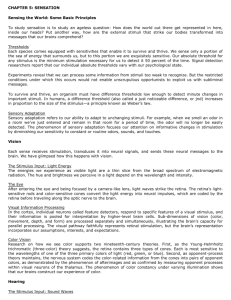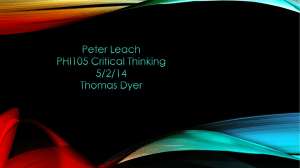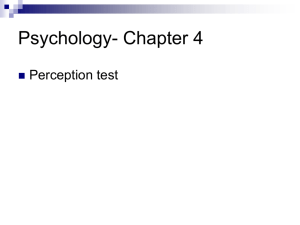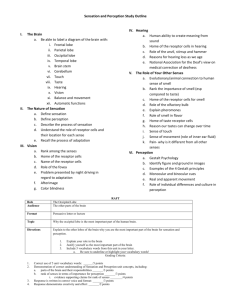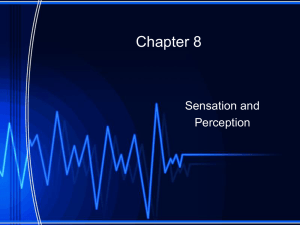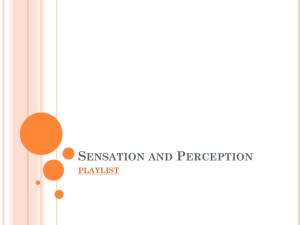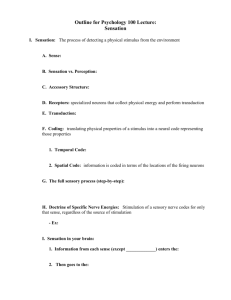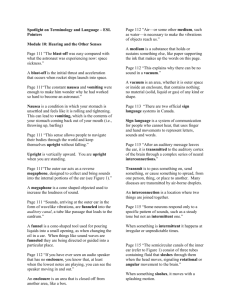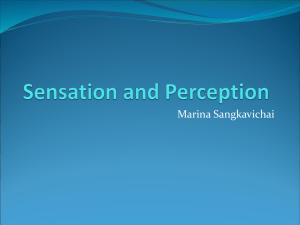Sense and percept
advertisement
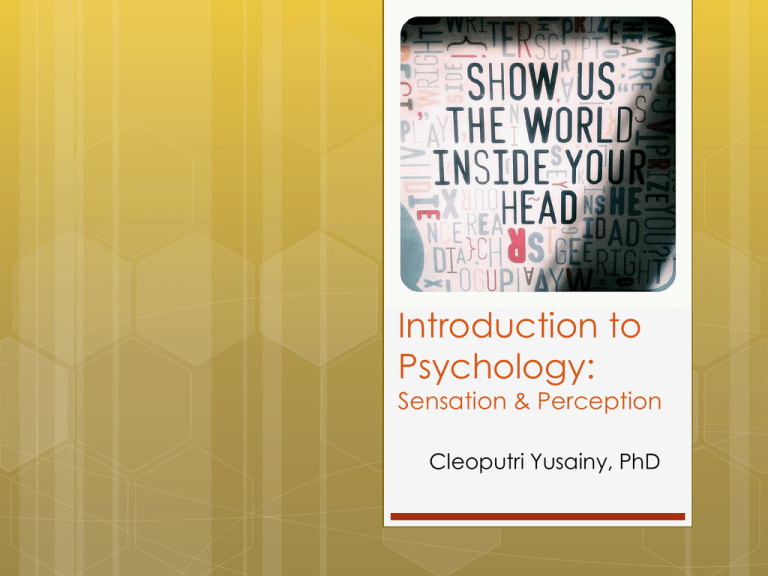
Introduction to Psychology: Sensation & Perception Cleoputri Yusainy, PhD Sensing the world To study sensation is to study an ageless question: How does the world out there get represented in here, inside our heads? Sensation is the conversion of energy from the environment into a pattern of response by the nervous system the registration of information. Perception is the interpretation of that information. How far do you think can an ant see? Depending on how far the light travels. Anything that stimulates the optic nerve is perceived as light. In or out? “When we look at someone or something, does anything such as rays, waves, or energy go out of our eyes? Into our eyes?” How your eyes work http://youtu.be/syaQgmxb5i0 1. Vision Light enters the eye through the pupil. It is focused by the lens and cornea and projected onto the retina. The retina’s visual receptors (light-sensitive rods and colorsensitive cones) convert the light energy into neural impulses. Neural impulses are coded by the retina before traveling along the optic nerve to the brain. “If we went to some other planet, would we see different colors?” Young-Helmholtz trichromatic (three-color) theory suggests that the retina contains three types of cones. Each is most sensitive to the wavelengths of one of the three primary colors of light (red, green, or blue). After staring at something blue, you get a yellow afterimage. After staring at yellow, you see blue; after red, you see green; after green, you see red; after white, black; and after black, white → Negative color afterimage. The nervous system codes the colorrelated information from the cones into pairs of opponent colors → Opponentprocess theory. 2. Hearing http://youtu.be/ HMXoHKwWmU8 When sound waves strike the eardrum (a), they cause it to vibrate three tiny bones (hammer, anvil, and stirrup) that convert the sound waves into stronger vibrations in the fluid-filled cochlea (b). Those vibrations create movement in tiny hair cells, triggering neural messages to the brain. 3. Touch Four basic skin senses: pressure, warmth, cold, and pain. Pain is an alarm system that draws our attention to some physical problem. A person’s experience of pain can be seen as the sum of: 1. 2. 3. Biological influences, ex. nerve fibers sending messages to the brain; Psychological influences, ex. the situation and our past experiences; Social-cultural influences, ex. cultural expectations and the presence of observers. 1. Vision 2. Hearing 3. Touch Suppose 4. Taste 5. Smell 6. Kinesthesis you had the godlike power to create a new species of animal, but you could equip it with only one sensory system. Which sense would you give it? Now imagine that you have to choose one of your senses to lose. Which one will it be? 4. Taste Taste, a chemical sense, is a composite of five basic sensations: sweet, sour, salty, bitter, and umami. Taste buds contain taste receptor cells. The influence of smell on our sense of taste is an example of sensory interaction. 5. Smell Like taste, smell is a chemical sense, but there are no basic sensations for smell. For most mammals, olfaction (the sense of smell) is critical for finding food and mates and for avoiding dangers. An odor’s ability to spontaneously evoke memories and feelings is due to the close connections between brain areas that process smell and those involved in memory storage. http://health.howstuffworks.com/mentalhealth/human-nature/perception/smell.htm Why do we have brains at all? Plants and sponges survive just fine without them. A sea squirt (a marine invertebrate) swims and has a brain during its infant stage, but when it transforms into an adult, it becomes a stationary filter feeder and eats its own brain! Ultimately, the purpose of a brain is to control behaviours, and behaviours are movements. 6. Kinesthesis Organizing a movement is not something we do at the end of our thinking. It is intimately intertwined with all of our sensory and cognitive processes. By means of millions of position and motion sensors all over our body, our kinesthetic sense monitors the position and movement of our individual body parts. Sensation & perception Our senses detect physical energy from the environment and encode it as neural signals → Sensation Aided by knowledge and expectations, our brain perceives meaning in these signals → Perception Is the link between sensation and perception ever simple? Visual capture Conflict between visual and other sensory information is usually resolved with the mind’s accepting the visual data, a tendency known as visual capture. But can you trust your eyes? http://youtu.be/ZflIMBxyIak Perception & attention The monkey business http://youtu.be/IGQmdoK_ZfY We selectively attend to, and process, a limited number of the data bombarding our senses and block out the others. This focused attention can result in inattentional or change blindness, and even choice blindness.
